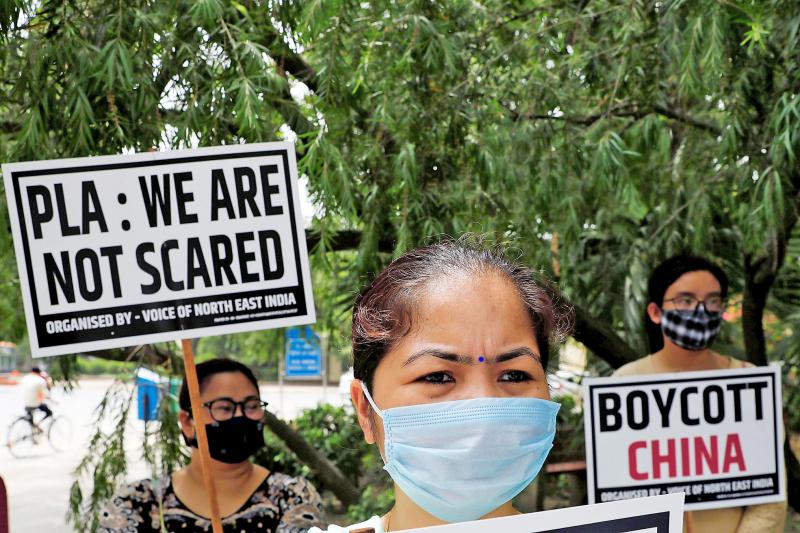India has told two state-run telecom firms to use locally made rather than Chinese telecom equipment to upgrade their mobile networks to 4G, a senior government source said on Thursday.
New Delhi’s move comes amid a backlash against companies from China after Chinese forces this week killed 20 Indian soldiers in a Himalayan border dispute.
The instruction is aimed at Chinese telecom gear makers Huawei Technologies Co (華為) and ZTE Inc (中興), the source said, after India last year announced an almost US$8 billion plan, some of which was earmarked for network upgrades, to help loss-making operators Bharat Sanchar Nigam Ltd (BSNL) and Mahanagar Telephone Nigam Ltd (MTNL).

Photo: Reuters
“Since that plan will be funded by public money they [BSNL and MTNL] should try to ensure they buy made-in-India equipment,” said the government source, who declined to be named as the order was not public.
The Indian Department of Telecommunications did not respond to a request for comment. The head of BSNL and MTNL did not answer calls or messages seeking comment.
Huawei declined to comment and ZTE, which potentially risks losing tens of millions of dollars in orders, did not respond to a request for comment. The Chinese embassy in Delhi also did not immediately respond to a request for comment.
Chinese companies face a public backlash after the worst clash since 1967 between China and India, where anti-Chinese sentiment is already strong.
Beijing has also come under fire over the coronavirus outbreak, with social media campaigns urging Indians to boycott Chinese goods.
The effective ban on the use of Chinese network gear could extend to private telecoms like Bharti Airtel Ltd and Vodafone Idea Ltd, which also use it in their networks.
“There will probably be some communication... maybe not a cease and desist, but a plea to avoid using Chinese equipment in core networks,” said a telecom industry source, who has worked closely with Chinese telecom equipment makers.
Any ban could increase costs for Indian telecoms, which would have to rely more on European firms like Nokia Oyj and Ericsson AB, as India has limited domestic expertise in telecom equipment manufacturing.

CHIP RACE: Three years of overbroad export controls drove foreign competitors to pursue their own AI chips, and ‘cost US taxpayers billions of dollars,’ Nvidia said China has figured out the US strategy for allowing it to buy Nvidia Corp’s H200s and is rejecting the artificial intelligence (AI) chip in favor of domestically developed semiconductors, White House AI adviser David Sacks said, citing news reports. US President Donald Trump on Monday said that he would allow shipments of Nvidia’s H200 chips to China, part of an administration effort backed by Sacks to challenge Chinese tech champions such as Huawei Technologies Co (華為) by bringing US competition to their home market. On Friday, Sacks signaled that he was uncertain about whether that approach would work. “They’re rejecting our chips,” Sacks

NATIONAL SECURITY: Intel’s testing of ACM tools despite US government control ‘highlights egregious gaps in US technology protection policies,’ a former official said Chipmaker Intel Corp has tested chipmaking tools this year from a toolmaker with deep roots in China and two overseas units that were targeted by US sanctions, according to two sources with direct knowledge of the matter. Intel, which fended off calls for its CEO’s resignation from US President Donald Trump in August over his alleged ties to China, got the tools from ACM Research Inc, a Fremont, California-based producer of chipmaking equipment. Two of ACM’s units, based in Shanghai and South Korea, were among a number of firms barred last year from receiving US technology over claims they have

It is challenging to build infrastructure in much of Europe. Constrained budgets and polarized politics tend to undermine long-term projects, forcing officials to react to emergencies rather than plan for the future. Not in Austria. Today, the country is to officially open its Koralmbahn tunnel, the 5.9 billion euro (US$6.9 billion) centerpiece of a groundbreaking new railway that will eventually run from Poland’s Baltic coast to the Adriatic Sea, transforming travel within Austria and positioning the Alpine nation at the forefront of logistics in Europe. “It is Austria’s biggest socio-economic experiment in over a century,” said Eric Kirschner, an economist at Graz-based Joanneum

OPTION: Uber said it could provide higher pay for batch trips, if incentives for batching is not removed entirely, as the latter would force it to pass on the costs to consumers Uber Technologies Inc yesterday warned that proposed restrictions on batching orders and minimum wages could prompt a NT$20 delivery fee increase in Taiwan, as lower efficiency would drive up costs. Uber CEO Dara Khosrowshahi made the remarks yesterday during his visit to Taiwan. He is on a multileg trip to the region, which includes stops in South Korea and Japan. His visit coincided the release last month of the Ministry of Labor’s draft bill on the delivery sector, which aims to safeguard delivery workers’ rights and improve their welfare. The ministry set the minimum pay for local food delivery drivers at